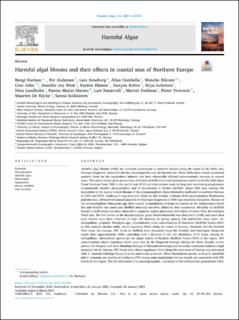| dc.description.abstract | Harmful algal blooms (HAB) are recurrent phenomena in northern Europe along the coasts of the Baltic Sea, Kattegat-Skagerrak, eastern North Sea, Norwegian Sea and the Barents Sea. These HABs have caused occasional massive losses for the aquaculture industry and have chronically affected socioeconomic interests in several ways. This status review gives an overview of historical HAB events and summarises reports to the Harmful Algae Event Database from 1986 to the end of year 2019 and observations made in long term monitoring programmes of potentially harmful phytoplankton and of phycotoxins in bivalve shellfish. Major HAB taxa causing fish mortalities in the region include blooms of the prymnesiophyte Chrysochromulina leadbeateri in northern Norway in 1991 and 2019, resulting in huge economic losses for fish farmers. A bloom of the prymesiophyte Prymnesium polylepis (syn. Chrysochromulina polylepis) in the Kattegat-Skagerrak in 1988 was ecosystem disruptive. Blooms of the prymnesiophyte Phaeocystis spp. have caused accumulations of foam on beaches in the southwestern North Sea and Wadden Sea coasts and shellfish mortality has been linked to their occurrence. Mortality of shellfish linked to HAB events has been observed in estuarine waters associated with influx of water from the southern North Sea. The first bloom of the dictyochophyte genus Pseudochattonella was observed in 1998, and since then such blooms have been observed in high cell densities in spring causing fish mortalities some years. Dinoflagellates, primarily Dinophysis spp., intermittently yield concentrations of Diarrhetic Shellfish Toxins (DST) in blue mussels, Mytilus edulis, above regulatory limits along the coasts of Norway, Denmark and the Swedish west coast. On average, DST levels in shellfish have decreased along the Swedish and Norwegian Skagerrak coasts since approximately 2006, coinciding with a decrease in the cell abundance of D. acuta. Among dinoflagellates, Alexandrium species are the major source of Paralytic Shellfish Toxins (PST) in the region. PST concentrations above regulatory levels were rare in the Skagerrak-Kattegat during the three decadal review period, but frequent and often abundant findings of Alexandrium resting cysts in surface sediments indicate a high potential risk for blooms. PST levels often above regulatory limits along the west coast of Norway are associated with A. catenella (ribotype Group 1) as the main toxin producer. Other Alexandrium species, such as A. ostenfeldii and A. minutum, are capable of producing PST among some populations but are usually not associated with PSP events in the region. The cell abundance of A. pseudogonyaulax, a producer of the ichthyotoxin goniodomin (GD), has increased in the Skagerrak-Kattegat since 2010, and may constitute an emerging threat. The dinoflagellate Azadinium spp. have been unequivocally linked to the presence of azaspiracid toxins (AZT) responsible for Azaspiracid Shellfish Poisoning (AZP) in northern Europe. These toxins were detected in bivalve shellfish at concentrations above regulatory limits for the first time in Norway in blue mussels in 2005 and in Sweden in blue mussels and oysters (Ostrea edulis and Crassostrea gigas) in 2018. Certain members of the diatom genus Pseudo-nitzschia produce the neurotoxin domoic acid and analogs known as Amnesic Shellfish Toxins (AST). Blooms of Pseudo-nitzschia were common in the North Sea and the Skagerrak-Kattegat, but levels of AST in bivalve shellfish were rarely above regulatory limits during the review period. Summer cyanobacteria blooms in the Baltic Sea are a concern mainly for tourism by causing massive fouling of bathing water and beaches. Some of the cyanobacteria produce toxins, e.g. Nodularia spumigena, producer of nodularin, which may be a human health problem and cause occasional dog mortalities. Coastal and shelf sea regions in northern Europe provide a key supply of seafood, socioeconomic well-being and ecosystem services. I | |
